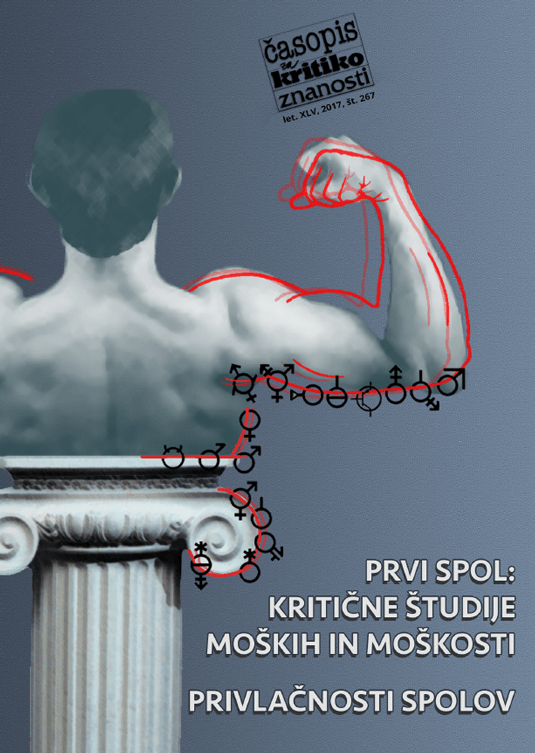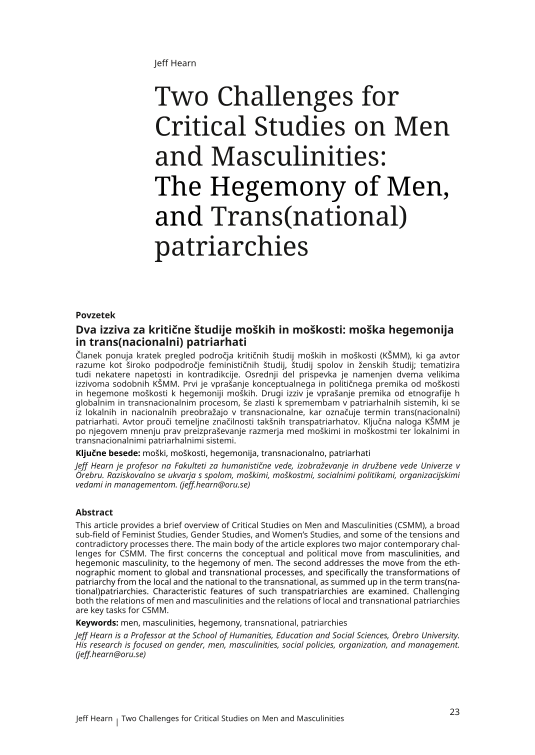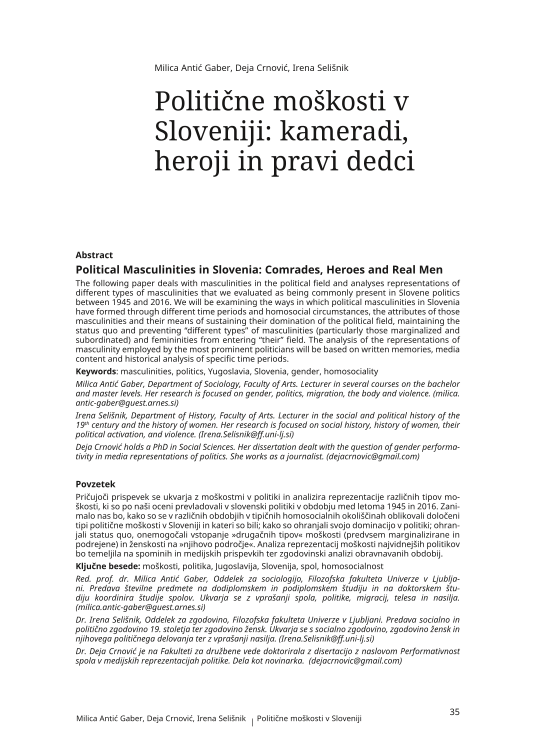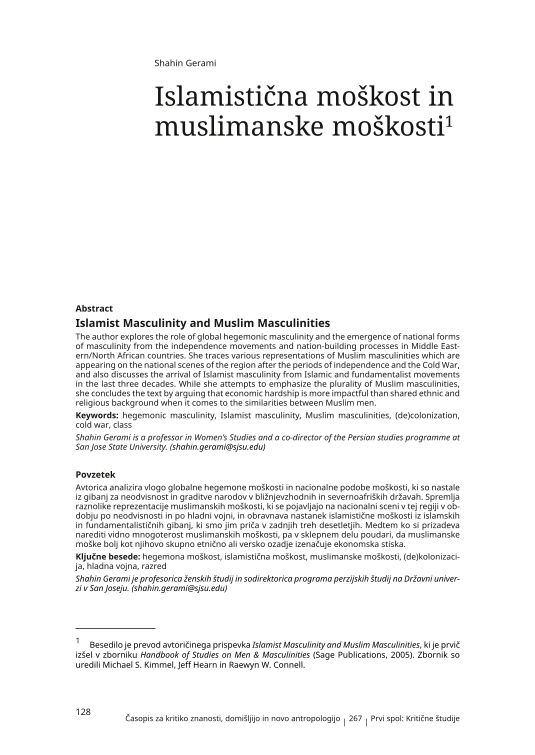Čeprav v zadnjih desetletjih narašča raziskovanje moških in moškosti kot ospoljenih, se koncept spola in spolnih razmerij pogosto še vedno razume, kot da zadeva predvsem ženske, ne pa tudi moških in številnih drugih spolnih kategorij ter poleg razmerij med moškimi in ženskami tudi razmerij med moškimi, med ženskami in med drugimi spoli. Moški in njihove vsakdanje javne in zasebne prakse so še vedno pojmovani kot spolno nevtralni, družbena konstrukcija in poustvarjanje kategorije moških in moškosti v konkretnih vsakodnevnih praksah, skozi institucije in v odnosih z drugimi kategorijami ostaja v dominantni vednosti neizrečena, nedvomljiva in skrita. Navidezno spolno nevtralnost kategorije moških in moškosti razumemo kot specifično obliko ospoljene moči in način dominacije, saj se moškost s tem vzpostavlja kot normalnost, kot univerzalna norma in merilo, kot središče, v odnosu do katerega se merijo »drugi« spoli. Zato je raziskovanje moškosti prispevek k dekonstrukciji samoumevnih, neizgovorjenih središč vselej spolno zaznamovane moči. Čeprav je kategorija moškosti v (političnih, ekonomskih, vojaških, simbolnih ipd.) centrih moči očitna, ostaja samoumevna, neproblematizirana, kot pravi Hearn (2015: 8; gl. tudi Hearn v tem tematskem bloku) »odsotno/prisotna« in neraziskana.
This article provides a brief overview of Critical Studies on Men and Masculinities (CSMM), a broad sub-field of Feminist Studies, Gender Studies, and Women’s Studies, and some of the tensions and contradictory processes there. The main body of the article explores two major contemporary challenges for CSMM. The first concerns the conceptual and political move from masculinities, and hegemonic masculinity, to the hegemony of men. The second addresses the move from the ethnographic moment to global and transnational processes, and specifically the transformations of patriarchy from the local and the national to the transnational, as summed up in the term trans(national)patriarchies. Characteristic features of such transpatriarchies are examined. Challenging both the relations of men and masculinities and the relations of local and transnational patriarchies are key tasks for CSMM.
The following paper deals with masculinities in the political field and analyses representations of different types of masculinities that we evaluated as being commonly present in Slovene politics between 1945 and 2016. We will be examining the ways in which political masculinities in Slovenia have formed through different time periods and homosocial circumstances, the attributes of those masculinities and their means of sustaining their domination of the political field, maintaining the status quo and preventing “different types” of masculinities (particularly those marginalized and subordinated) and femininities from entering “their” field. The analysis of the representations of masculinity employed by the most prominent politicians will be based on written memories, media content and historical analysis of specific time periods.
The article theoretically and ethnographically presents the genealogy of the (re)production of hegemonic masculinity through military service on the territory of Slovenia. It commences by delineating the recent history of conscription and its regulations, as the obligation to serve in the armed forces has always played an important part in the construction of spatialized masculinities. Various mechanisms of establishing a socialist heteronormativity in practice are discussed later – from state-regulated measures and performative practices to community customs. Given the assumption that the development of nation states and conscription are parallel to the process of constructing hegemonic masculinity, the naturalization of the relation between the specifically determined masculine and feminine is shown through diverse examples. A particular analytical focus is placed on the military masculinity present within the Yugoslav People‘s Army (YPA) and its reinforcement of asymmetrical power relations between genders. The productive distinction between external and internal hegemonic masculinity is introduced through the concept of militant socialist masculinity. The case of the YPA suggests that internal hegemonic masculinity coexisted with other forms of non-hegemonic masculinity. Tattooing and homoeroticism in the YPA are presented as examples of how such subordinated, non-hegemonic masculinity manifested itself.
The world is becoming increasingly interconnected in the economic field. In order to find new profitable niches, capitalism uses all the available discourses to attract consumers. Transnational corporations have to differentiate their products on a local level in order to reach the broadest public possible. The aim of this article is to explore, through the use of the method of discourse analysis, how this differentiation is apparent in the Slovenian advertising space, where two different approaches for branding beer are used. The advertising approaches employed by both of the analysed beer brands, Laško and Union, use Slovenian national myths and images of masculinity that consumers can identify with. The advertising of beer through masculinity contributes to the public sphere being gendered as masculine, especially when it comes to its most prestigious positions.
On a general level, the article can be grouped with other studies that explore the ways in which men’s practices shape masculinities, and assess the impact of those constructions on men themselves and others. The author traces the development of scholarship focusing on men, masculinities, and sport. He describes the contributions that this research has made to more general scholarly work on masculinities, the body, health, and violence. The article is concluded by an outline of the new directions in research on men and sport – particularly studies that examine sport as an institutional and cultural context for power relations between women and men and between various groups of boys and men.
In this paper, the concept of Gender Based Violence (GBV) is exemplified by different constellations of violence involving men acting either as perpetrators or as victims. GBV is usually defined in a broad way and can cover the main field of violence between the genders (men as perpetrators, women as victims) as well as other constellations of perpetrators and victims, e.g. violence between men. The scope of the concept of GBV is, however, seldom used in its entirety. Based on a broad definition of GBV, three topics are discussed with the intention of emphasizing the relevance of an extended and gendered perspective on men and violence: First, we will be looking at the topic of violence in public spaces being committed by men against other men as a form of Gender Based Violence, with the potential of motivating men for change and for taking a stand against a distorted male socialization. The second topic is violence in heterosexual partnerships, which has become a subject of public debate, where the insistence on the gender symmetry of domestic violence has served as an anti-feminist argument in the ideological discourse, bringing new challenges to public communication. The third area of focus is the sexual abuse of boys, which has often been overlooked because of the relation between male socialization and a taboo form of violence that makes disclosure processes difficult. Thinking about such constellations of violence can improve not only our theory and concepts, but the victim support structures and intervention programs for perpetrators of violence as well.
The author explores the role of global hegemonic masculinity and the emergence of national forms of masculinity from the independence movements and nation-building processes in Middle Eastern/North African countries. She traces various representations of Muslim masculinities which are appearing on the national scenes of the region after the periods of independence and the Cold War, and also discusses the arrival of Islamist masculinity from Islamic and fundamentalist movements in the last three decades. While she attempts to emphasize the plurality of Muslim masculinities, she concludes the text by arguing that economic hardship is more impactful than shared ethnic and religious background when it comes to the similarities between Muslim men.
Unsettling and Stabilizing Social Order: Educational Discourse Targeting Young Muslim Males
(
Taking a closer look at the educational discourse on young Muslim males with its focus on gender--based violence and Islamic fundamentalism, this article reflects on the European and especially the German political background of educational tasks and educational research. With regard to gen-der regimes and ethnic-cultural demarcations within the national context, educational discourse is described as an arena in which social order is both unsettled and stabilized. In this dominant disco-urse young Muslim males are considered a menace. The article highlights its mechanisms: the disre-garding of hegemonic masculinities (Connell) and the definition of a general lack of education on the part of the others. Hence, the framework of integration, migration, and religious-cultural diffe-rence is critically reflected. Focusing and controlling the Muslim other is discussed as an evasion of societal change to which education contributes. A critical perspective on gender-based violence and social disintegration unveils the unreflected production of educational expertise about Muslims.
The article tackles contemporary fatherhood in the context of changing masculinities and the relation between care work and paid work . The main thesis is that the labour market and the position of the individual within it influence the care work of fathers in their private lives. Using the qualitative research of the project Fathers and Employers in Action, we show the influence of paid work on two groups of fathers; those in precarious forms of employment and those in leading and managerial positions. In the group of fathers that are in precarious forms of employment, changes in caring fatherhood and variations in the relation between paid work and parenting practices can be observed. Fathers in precarious forms of employment also face the lack of social and workers’ rights and are thus in disadvantaged positions when attempting to establish a balance between their work and their personal life. The group of fathers in leading and managerial positions exhibits the prevailing hegemonic masculinity and the breadwinner model with limited participation in the care for children, which can be described as ’weekend fatherhood’.
One of the important characteristics of the modern labor market is gender segregation. Women find it hard to enter male-dominated professions, and most men see feminized professions as unattractive because they are not associated with high wages and desirable social status. The men who do decide to enter such professions face both positive and negative responses from their work and social environment. Child care and preschool education is a highly feminized field of work. This article aims to contribute to the analysis of gender segregation in the labor market by analyzing the situation of men who are working in the female-dominated profession of preschool teaching. We are presenting an overview of the literature and the results of recent empirical research done in Slovenia (101 surveys among parents of children attending kindergartens, 68 surveys among male primary school students and 18 interviews with female and male preschool teachers and kindergarten principals). We found that parents, teachers and principals express a positive attitude towards the increase in the number of male preschool teachers in Slovenian kindergartens. On the other hand, young boys are not interested in care professions because they consider them more appropriate for women. Based on the analysis, we estimate the possibilities for the defeminization of teaching professions and present possible incentives that could contribute to a greater presence of men in early childcare and education. We would like to contribute to the discussion on the possibilities and means of reducing horizontal gender segregation.
The main goal of this paper is to present contemporary men’s initiatives aimed at increasing gender equality in Europe. The particular phenomena will be analyzed in three main dimensions: transnational networks, national umbrella networks and national groups and organizations. The vast majority of the paper’s findings are based on the results of the European research project “Role of men in gender equality” (EC PROGRESS Programmed) conducted in 2011 and 2012 in 31 European countries and framed with the usage of the MA’AM typology of contemporary men’s social movements developed within the critical men and masculinities studies approach.
Izhodišče pričujočega bloka je moje opažanje, da se o temah, kot so spolnost in spoli, različne oblike spolne usmerjenosti, spolne identitete, ali pa na primer spolnost in državljanstvo, občutno premalo piše, govori in razpravlja. Poglobljene obravnave spolnosti se pri nas izogibamo, čeprav je po drugi strani vseprisotna, na primer v filmih, reklamah in revijah. O enem od mogočih razlogov za to sem pisala v knjigi Živeti, v eseju z naslovom Seksualnost (2012, 61–91): človeška spolnost je povezana predvsem z vplivom užitka na nas, ko spolnost udejanjamo, mislimo in razmišljamo o njej. Povezana je z (izjemno) močjo in avtonomijo užitka, o katerem je veliko razpravljal že Platon.
In the chapter Sexual concepts from the book Philosophy of Sex and Love the author presents different views and attitudes on how we can understand what is sexual and under what conditions something can be called sexuality; can a mere touch be called sexual or must we have sexual intercourse; is love necessary for the sexual act or can we be aroused and have sexual intercourse without love? Is sexuality connected solely to reproduction? He explains why homosexual intercourse is on the same sexuality scale as heterosexual even though it can‘t produce children. The author also explores the concept of sexuality being socially constructed and not existing per se, and argues that sexuality has a stronger connection to touch as a form of communication between partners that stimulates the enrichment of sensations than to the act of sexual intercourse itself.
There is hardly a weaker connection between the titular signifiers and natural reproduction than in same-sex sexuality. Though seemingly non-functional for natural reproduction, it has a firm place in evolution, having been described in 450 and noted in 1500 animal species. Some genetic theories that have attempted to explain the mechanism in humans are briefly outlined and annotated. Same-sex sexuality (between men more visibly than between women) is present throughout written history, marked by varying forms and degrees of sexual discipline. The paper includes historical review, epistemological consideration, and clinical experience. The vicissitude of same-sex sexuality is interesting per se, but it also corroborates the initial premise that it is a biologically supported mechanism, as it survived even the most unfavourable regimes. The author argues that the gender of the subject and the object are two sides of the same function that benefits reproduction by varying and combining gender-related properties. Sexual activities are more susceptible to discipline, but in an unexpected sense.
Why was women‘s sexuality always the one that was strictly controlled throughout history? The article bases its answer on the fact that the reproduction of the population is a necessary condition for the existence of any society. In this context, the main “producers“ of people are women. Their natural reproductive abilities are used as an excuse to reduce their societal role to childbearing and also function as the basis of their subordination in an androcentric social order. The author focuses on functional heterosexual sexuality, a field that has been strictly managed for centuries on an institutional level. She analyzes the main factors that enabled the (connected) reproduction of the sexual and class order on the micro- and macro-levels. History shows that this reproduction was based on the premise that the woman “belongs to the man“. This premise has its origins in the 1st millenium BC and was later reinforced in Western civilization through Christianity and the Catholic Church. Despite the slow erosion of androcentrism and the advancement of secularization processes, repressive patterns of regulating (“fruitful“) sexuality still persist in the 21st century, mainly because of the erosion of the welfare state.
In her article, Dickenson discusses the meaning and impact of the feminist critique regarding women’s sexuality in the context of modern reproductive technologies, especially stem cell research, IVF and the selling of human eggs on the market. The author shows how feminist thought influenced the field of practical bioethics and how feminists approached the interesting and often complex challenges that stem from the fundamental concepts of bioethics. Feminist scholars in the field of bioethics have used praxis to inform theory and theory to inform praxis in a dialectic manner. Three principal foci of this theoretical re-examination of canonical concepts have developed: 1) property in the body, including its alienation, and exploitation; 2) autonomy and freedom of choice; and 3) embodiment.
The authors analyze current social and political affairs and the rise of right-wing populism in Slovenia. They examine secondary sources to analyze the events during the parliamentary process and the referendum campaign concerning the proposed Family law in 2012, and the same is done for the referendum on the Act amending the Marriage and Family Relations Act in 2015. Both laws would have provided the equality of same-sex couples in marriage. Through the lens of current Slovenian and global sociopolitical affairs, they draw parallels between the rise of right-wing populism in Slovenia and the rest of the world. They show that a key component of populism is the fact that it creates the impression that the movement is arising from the people themselves, in contrast to the established political elites. They explain the use and the effects of the simple rhetoric, natural truths and fear utilized by right-wing populism.
The article’s objective is to tackle the main types of the representation of lesbian sexuality in film production, particularly in mainstream classics. Whereas the first lesbian love scenes in the 1930s focused on kisses, playful masquerade, cross-dressing and innuendos, lesbian imagery during the US film censorship period remained negative until the end of the 1960s, with most sexual scenes implying a prevailing Thanatos-inclination, a death-drive bordering on horror. In the aftermath of the sinister period of lesbian dramas, the 1970s came with the liberation of lesbian film imagery in art films, women’s films and feminist films from Europe and the USA, although their imagery can prove to be problematic for a lesbian viewer. The limitations of the depiction of lesbian eroticism on screen were pushed further by diverse genres, most notably by independent lesbian shorts, in which the female directors themselves took up film acting, thereby swapping the overly predictable position of the female voyeur with the active role. In the 21st century, lesbian themes in mainstream films are represented more and more overtly. The depiction of lesbian sexuality is, however, still sometimes implemented through male characters as agents of the lesbian desire, and familiar film clichés are still being effectively combined to compose new film imagery of lesbianism.
We became human by becoming equal, by sharing childcare, sharing meat and sexual joy, but with the coming of class societies and class hierarchies systematic patterns of inequality between men and women also appeared. Sexual violence – beatings, rape and abuse – were central to this new class order. So was love, but love now locks us into class hierarchies and sexism. Here, our aim is to explain why sexual experiences and images, and notions of masculinity and femininity differ in different times and places, for which neoliberalism offers a perfect laboratory for such a comparative project.
FEBVRE, LUCIEN (2015): Boj za zgodovino in Civilizacija. Beseda in ideja. Ljubljana: Studia Humanitatis.
Na prvi pogled bi se nam lahko zdelo, da so časi, v katerih je živel in deloval zgodovinar Lucien Febvre (1878–1956), že zdavnaj minili in da so se njegove ideje že uveljavile tudi v slovenskem prostoru. Zgodovinopisje se namreč že dolgo ne ukvarja več samo s politično in vojaško zgodovino, obstajajo tematsko zelo različni časopisi in revije s področja zgodovinopisja, študentke in študenti lahko študirajo tudi socialno zgodovino, spodbujajo se interdisciplinarnost in skupinske študije. Postavlja se nam torej vprašanje, kaj se lahko sploh še naučimo od soustanovitelja znamenite francoske revije Annales d‘histoire économique et sociale, ko pa se zdi, da so njegove ideje že postale del proučevanja zgodovine, in mu lahko kvečjemu namenimo posebno mesto v zgodovinskih pregledih zgodovinopisnih teorij? Odgovor na to vprašanje je lahko njegova knjiga Boj za zgodovino in Civilizacija. Beseda in ideja, ki nam jasno pokaže, da Febvrovih idej ne moremo zavreči. V knjigi je zbranih 16 recenzij, razprav in predavanj, dodana pa je tudi razprava Civilizacija. Beseda in ideja. Razprave so bile objavljene med letoma 1906 in 1952, torej gre za misel, ki vključuje skoraj celo obdobje njegovega znanstvenega (ne pozabimo, da je za Febvra zgodovinopisje znanost) delovanja. Čeprav razprave obravnavajo zelo raznolike teme, lahko v njih razberemo jasno rdečo nit, ki pomeni Febvrovo razumevanje zgodovine.
PELIKAN, EGON (2016): Tone Kralj in prostor meje. Ljubljana: Mladinska knjiga.
Knjiga s številnimi reprodukcijami likovnih del pripoveduje o okoliščinah in vsebinah cerkvene umetnosti Toneta Kralja (1900–1975), ki je na Primorskem pod fašizmom bičala fašizem. Predstavlja nam izjemno likovno gradivo v kontekstu malo znanega zgodovinskega dogajanja in dokazuje, da se nikjer v Evropi ne morejo ponašati s tako številno antifašistično umetnostjo, povezano z antifašističnim gibanjem. Če bi se mogli, bi bila tovrstna ustvarjalnost brez dvoma sestavni del svetovnih kurikulov umetnostne zgodovine, zgodovine in političnih ved. O njih bi ljudje po svetu vedeli vsaj toliko, kolikor vemo pri nas o impresionizmu in partizanskih gibanjih. Zato je knjiga, ki je prvovrstni dosežek znanosti, publicistike in založništva, odličen prvi korak za uvrstitev obravnavane teme v mednarodni umetnostni in zgodovinski prostor.
ZAVIRŠEK, DARJA, GAŠPER KRSTULOVIĆ, VESNA LESKOŠEK, PETRA VIDEMŠEK, MONIKA BOHINEC, ELENA PEČARIČ, NATALIJA JESENIČNIK IN KLAUDIJA POROPAT (2015): Analiza sistema institucionalnega varstva in možnosti nevladnih organizacij zagotavljati storitve v skupnosti za uresničevanje deinstitucionalizacije v Sloveniji. Ljubljana: YHD – Društvo za teorijo in kulturo hendikepa.
Kot pove že sam naslov – tukaj bomo uporabljali njegovo okrajšavo Analiza –, gre za zahtevno in kompleksno študijo več avtorjev in avtoric, ki za svoj cilj ne jemljejo zgolj opisa stanja na področju socialnega varstva, temveč poskušajo odgovoriti tudi na vprašanje, kako socialno varstvo preoblikovati pri odpravljanju javnih varstvenih institucij ob spremljajoči integraciji ljudi z ovirami v večinsko populacijo.
SLORACH, RODDY (2015): A very capitalist condition: A history and politics of disability. London: Bookmarks.
V pričujoči monografiji Roddy Slorach ponuja zelo natančen politični in družbeni pregled obravnave hendikepa skozi zgodovino Velike Britanije z vidika marksistične kritike kapitalizma in nam ponuja možnosti za emancipatoričen moment. Ta trenutek nastane zgolj s spremembo optike pogleda hendikepiranih na same sebe, na družbo, ki jim v vsakdanjem življenju postavlja ovire, lažne mite in vzore ter na medsebojne odnose.
Tovrstna emancipatorična perspektiva pa ni pomembna zgolj za same aktiviste gibanja za neodvisno življenje, ampak prav tako nudi tudi priložnosti, da se temu pridružijo različne tako ali drugače diskriminirane manjšine. Število različnih skupin z multiplo diskriminacijo ne upada, temveč se kljub navideznemu odpiranju novih možnosti neenakosti samo še povečujejo in multiplicirajo, širijo, raztezajo. Takšna je pač kruta logika kapitalizma samega, ki ima že v svojem temeljnem ustroju vpisano nenehno revolucioniranje produkcijskih sredstev in razmerij v družbi. Vse napreduje, vse se razvija, vse raste …, a do kod?
MASTNAK, TOMAŽ (2015): Liberalizem, fašizem, neoliberalizem. Ljubljana: */cf.
»Fašizem je v politični zgodovini tesno povezan z liberalizmom. To trditev bom poskušal v tej knjižici utemeljiti. Tu na začetku, kot uvodni stavek, pa mora zveneti provokativno. Na razmerje med liberalizmom in fašizmom smo namreč navajeni gledati kot na nasprotje. (…) Videli bomo pa tudi, da to razmerje nikdar ni bilo v načelu izključevalno, da je liberalizem tudi takrat, ko je bil v konfliktu s fašizmom, gledal nanj kot na relativnega – in ne absolutnega – sovražnika. Vedno je bilo kaj hujšega od fašizma.« (Mastnak, 2015: 7)




























